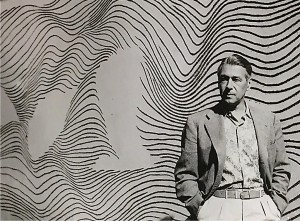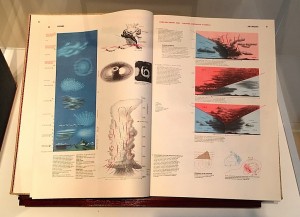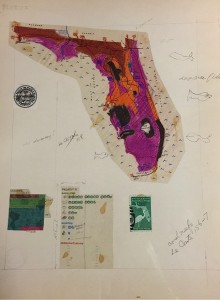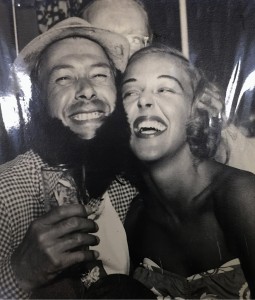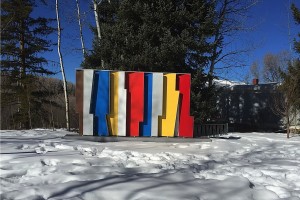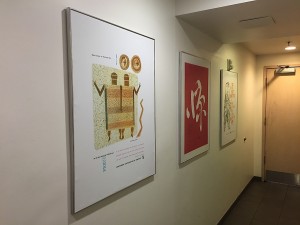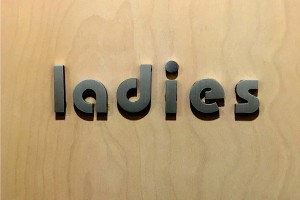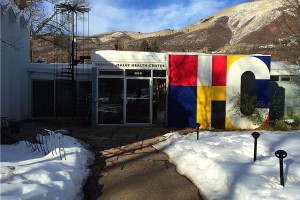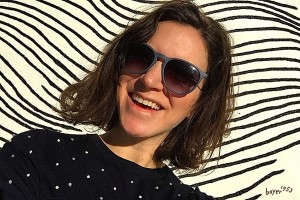Kate Tucker is an art history graduate student completing her qualifying paper on Walter Paepcke’s patronage of Herbert Bayer’s design initiatives at the Container Corporation of America and the Aspen Institute. She was awarded the Art History Department Graduate Research Grant to help make this project possible. Kate will be presenting her qualifying paper research at the Art History Graduate Forum on May 22.
Herbert Bayer lived in Colorado for 28 years [Picture 1]. During this period he was able to employ his Bauhaus training through a total design of the Aspen Institute and advance the visual communication initiatives at the Container Corporation. Walter Paepcke, chairman of Container Corporation, was the patron that convinced Bayer to move to the small town of Aspen. Together they made the location into a culturally thriving resort destination. To further understand Bayer’s design work produced during this period, I recently took a trip to Denver and Aspen. This was made possible through a travel research grant provided by St. Thomas. The grant provided funds for airfare to Denver, and a rental car and lodging in Aspen. Without this grant, the trip would not have been possible.
The first stop on the trip was to the Herbert Bayer Archive and Collection at the Denver Art Museum [Picture 2]. The museum holds over 8,000 pieces of art and extensive documentary material on the artist. One of the things that most interested me in the collection is the original paste-ups from Bayer’s World Geo-Graphic Atlas [Picture 3]. This atlas was published in 1953 for Container Corporation after a five-year undertaking. The book, which had a limited release of 30,000 copies, was produced as a memento for Container Corporation’s customers and shareholders. It contains over 1,200 individual and unique charts, diagrams, detail maps, and pictures. The collection of paste-ups reveals the early sketches of the finished project of the atlas. Pencil drawings were later fulfilled in the final rendering [Picture 4]. Bayer developed a system of agricultural markers on these paste-ups that would be fine-tuned in the final version [Picture 5]. The paste-up’s pages reveal the overall layout and the tight spaces for text, which Bayer would write and edit himself to maintain its cohesive order and focus on the visual images.
I spent a lot of time at the museum looking through scrapbooks of Bayer’s wife, Joella. She also compiled photo albums that included pictures ranging from Paepcke, Bayer, and Gary Cooper socializing in Aspen [Picture 6], to a lively party called “Come as Your Neurosis.“ [Picture 7]. While the scrapbooks revealed how Bayer was perceived and praised for his contributions, the photo albums show the jolly side to Bayer’s life in the mountains.
After Denver, I drove three hours to Aspen. The mountain drive is beautiful and along the highway there are a series of ski towns, while Aspen is far off the main drag. The travel made it clear that back in the 1940s, Aspen was a place of new discovery. Paepcke was the one who brought attention and enthusiasm to the revival of the town.
I stayed at the Aspen Meadows. The first thing I saw as I approached the retreat center was Kaleidscreen, one of Bayer’s art installations [Picture 8]. I was surprised by how small it looked against the background of the Aspen Institute and mountains. My impressions from photos had been greatly misled. As I entered the lobby, Bayer’s presence was felt throughout [Picture 9]. Every corner was filled with original Bayer artworks, posters from the “Great Ideas” advertising series at Container Corporation, even Bayer’s universal type was used at every opportunity, including in the bathrooms [Picture 10].
Bayer designed the majority of the buildings on the Aspen Institute campus in the 1950s in the vein of Bauhaus and International Style. Paepcke selected Bayer to design the environment for his pet project. Prior to my visit I was skeptical about how much of Bayer’s original designs would still be present over a half of decade later. I was pleasantly surprised at the clear intention to restore and maintain the spaces in their original mid-century modern design. Bayer’s use of primary colors from his Bauhaus days was still intact, as seen on the mural outside of the health center [Picture 11]. Even the sgraffito mural outside of the Koch Seminar Building looked as it did when it was first installed [Picture 12]. There has been a clear vision to maintain the design of these buildings through restorations, even long after Paepcke and Bayer’s death. There is a sense of timeless serenity felt at the Aspen Institute that speaks to the cohesive vision the Bayer applied to the space.
Bayer’s design of the Aspen Institute has been carefully carved into its natural landscape. His work in Aspen inspired the visual communications at Container Corporation. The beauty of the atlas speaks to Bayer’s love of nature and freedom to find design solutions when given the opportunity from a wealthy patron. The trip to Colorado solidified my understanding on how the interdependence between Paepcke and Bayer correlated with the design initiatives at the cultural retreat and corporation.
